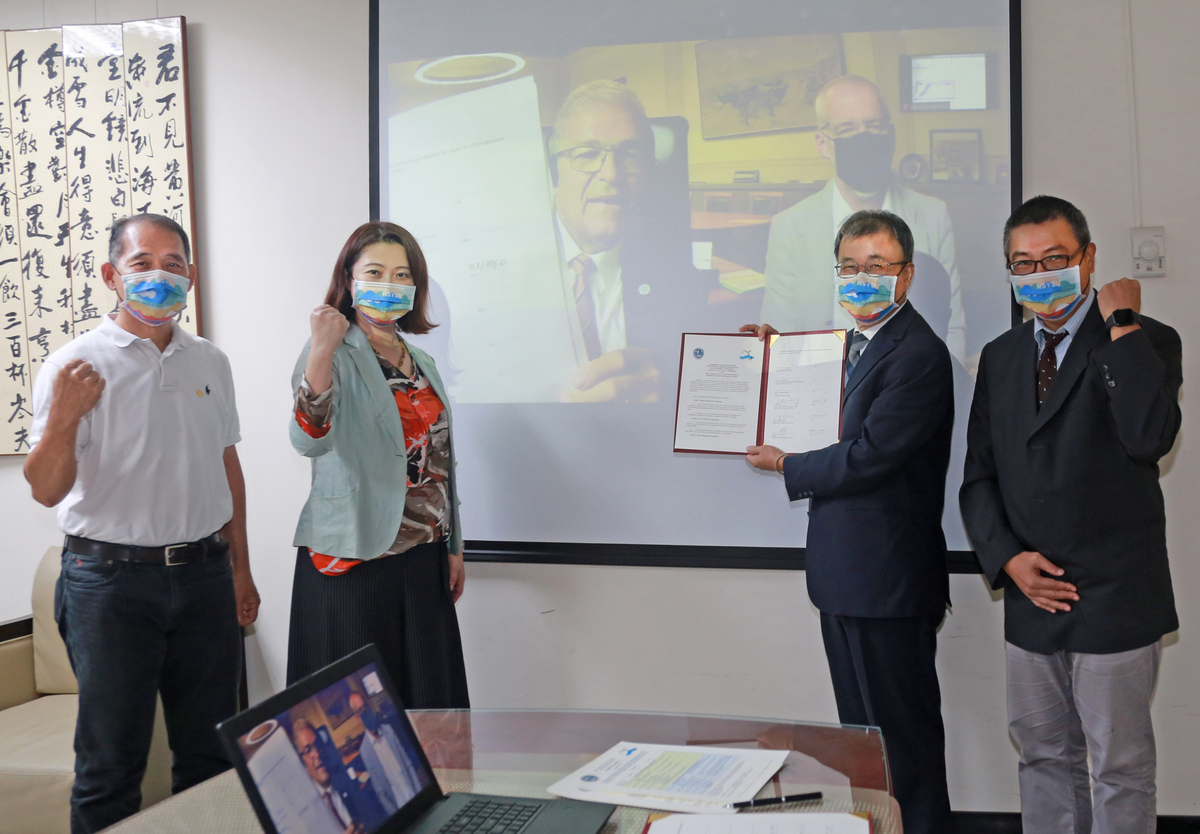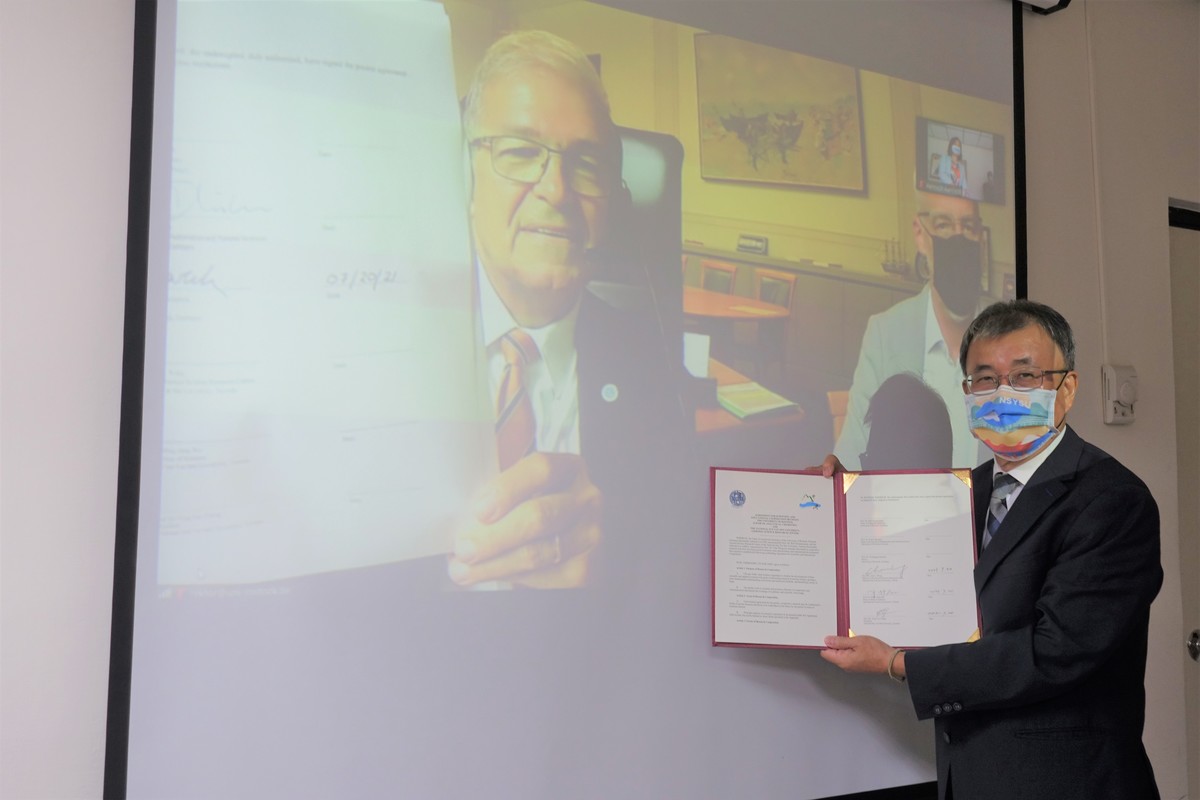NSYSU and University of Rostock tie cooperation in aerosol science


2021-08-02
As the pandemic struck the world, World Health Organization (WHO) has recently confirmed that aerosols are the main route of transmission of COVID-19. Aerosol Science Research Center at National Sun Yat-sen University and the aerosol science research team at the University of Rostock (UR) in Germany have signed a memorandum of understanding and hosted an international online research conference on aerosol science, joining hands to fight air pollution and aerosol transmission (also called airborne transmission) of communicable diseases. Both universities have announced that they will further explore the chemical characteristics of aerosols, develop cutting-edge aerosol detection technology, study aerosol formation mechanisms, emission reduction strategies, and the impact of different types of aerosols on human health. In the future, they will apply the most advanced aerosol mass spectrography to conduct local detection and analysis of aerosols in real time and facilitate tracing the source of emission.
The University of Rostock, situated in northern Germany, is the oldest university in the Baltic Sea Region. Two pioneers of quantum physics in the modern era – Albert Einstein and Max Planck were awarded honorary doctorates by UR. NSYSU President Ying-Yao Cheng emphasized that the global scale of COVID-19 transmission reflects the close connection between people through the air they share. Therefore, countries worldwide should cooperate to ensure that everyone breathes clean air free of pollution, PM2.5, and pathogenic aerosols. Dean of the College of Science Ming-Jung Wu said that issue-oriented interdisciplinary research and teaching is an important current trend worldwide; to solve a major issue, very often it is necessary to integrate a few fields of professional knowledge. Currently, NSYSU Aerosol Science Research Center brings together domestic and international experts in science, engineering, marine sciences, and social sciences to explore the urgent need to improve air quality and find strategies for the various diseases caused by air pollution, showing the best example of interdisciplinary research and teaching.
The webinar session following the signing ceremony was an opportunity for both universities to share their ongoing research, findings, and developed technologies. Although the proportion of emission sources and levels of air pollution in both cities differ, Kaohsiung and Rostock are both port cities affected by shipping industry emissions which is the shared issue studied by researchers of ASRC and the University of Rostock. ASRC has been collaborating with Taiwan International Ports Corporation to help it reduce emissions, and UR researchers developed technology to detect metals in aerosols and address the need for a novel approach to ship plume tracking. The signing of the agreement between the Chair of Analytical Chemistry and Aerosol Science Research Center is only the beginning – speakers of both universities have expressed hopes for closer cooperation that would expand beyond the field of aerosol science to natural sciences and medicine.
In addition to the MOU signed with the University of Rostock, agreements have been signed with two other universities with aerosol research centers, including the Center for Aerosol Impacts on Chemistry of the Environment, University of California, San Diego, US, in 2019 and Southern Ontario Centre for Atmospheric Aerosol Research, University of Toronto, Canada in 2020. ASRC Director Chia C. Wang pointed out that according to WHO’s statistics, over 90% of the global population breathes air containing high levels of pollutants, and the situation is dire in Asia. Recent studies have shown high rates of infection, severe illness, and death from COVID-19 in areas with severe air pollution, which is hypothesized to be related to chronic lung diseases or bad lung health and weakened immunity due to long-term exposure to air pollution. The findings reflect the close relationship between the environment and people and stresses the importance of improving air quality for human health. ASRC has succeeded in developing a number of cutting-edge aerosol detection technologies unique in Taiwan and even in the whole of Asia, such as Aerosol VUV Photoelectron Spectroscopy, Time-Resolved Aerosol Infrared Spectroscopy, Raman Optical Tweezers, and LiDAR facilities, which have achieved considerable international visibility and leadership position.
The Center has built close international connections, is actively expanding its international influence, engaging with the community, and working with local industry to help it overcome current technological bottlenecks by developing new and innovative technologies to improve air quality, alleviate the problem of PM2.5, and protect the environment and public health.
Note:
ASRC is the only research center focused on aerosol science in Asia. Launched in 2016, the Center is committed to aerosol-related research, including exploring the impact of aerosols on the atmosphere and marine ecology and climate change, tracing PM2.5 pollution sources and emission reduction strategies, studying the impact of PM2.5 on human health and its pathogenic mechanisms, and such important research areas as PM2.5 preventive medicine and aerosol biomedical science.
Since the outbreak of the COVID-19 pandemic, Director Wang has been working on the mechanisms of airborne transmission of the virus through bioaerosols and prevention strategies and has published a perspective article in Science, a prestigious international journal. Since its publication in May last year, the article has been covered by over 250 media channels worldwide, including CNN, NBC, New York Post, FOX News, Forbes, and Physician’s Weekly, and has been downloaded over 1.68 million times. The article has triggered global attention to this issue and led the WHO and the CDC in the US to include the prevention of aerosol virus transmission into their policy in late April and early May this year, which demonstrates the worldwide influence of Taiwan’s aerosol science research.
As the pandemic struck the world, World Health Organization (WHO) has recently confirmed that aerosols are the main route of transmission of COVID-19. Aerosol Science Research Center at National Sun Yat-sen University and the aerosol science research team at the University of Rostock (UR) in Germany have signed a memorandum of understanding and hosted an international online research conference on aerosol science, joining hands to fight air pollution and aerosol transmission (also called airborne transmission) of communicable diseases. Both universities have announced that they will further explore the chemical characteristics of aerosols, develop cutting-edge aerosol detection technology, study aerosol formation mechanisms, emission reduction strategies, and the impact of different types of aerosols on human health. In the future, they will apply the most advanced aerosol mass spectrography to conduct local detection and analysis of aerosols in real time and facilitate tracing the source of emission.
The University of Rostock, situated in northern Germany, is the oldest university in the Baltic Sea Region. Two pioneers of quantum physics in the modern era – Albert Einstein and Max Planck were awarded honorary doctorates by UR. NSYSU President Ying-Yao Cheng emphasized that the global scale of COVID-19 transmission reflects the close connection between people through the air they share. Therefore, countries worldwide should cooperate to ensure that everyone breathes clean air free of pollution, PM2.5, and pathogenic aerosols. Dean of the College of Science Ming-Jung Wu said that issue-oriented interdisciplinary research and teaching is an important current trend worldwide; to solve a major issue, very often it is necessary to integrate a few fields of professional knowledge. Currently, NSYSU Aerosol Science Research Center brings together domestic and international experts in science, engineering, marine sciences, and social sciences to explore the urgent need to improve air quality and find strategies for the various diseases caused by air pollution, showing the best example of interdisciplinary research and teaching.
The webinar session following the signing ceremony was an opportunity for both universities to share their ongoing research, findings, and developed technologies. Although the proportion of emission sources and levels of air pollution in both cities differ, Kaohsiung and Rostock are both port cities affected by shipping industry emissions which is the shared issue studied by researchers of ASRC and the University of Rostock. ASRC has been collaborating with Taiwan International Ports Corporation to help it reduce emissions, and UR researchers developed technology to detect metals in aerosols and address the need for a novel approach to ship plume tracking. The signing of the agreement between the Chair of Analytical Chemistry and Aerosol Science Research Center is only the beginning – speakers of both universities have expressed hopes for closer cooperation that would expand beyond the field of aerosol science to natural sciences and medicine.
In addition to the MOU signed with the University of Rostock, agreements have been signed with two other universities with aerosol research centers, including the Center for Aerosol Impacts on Chemistry of the Environment, University of California, San Diego, US, in 2019 and Southern Ontario Centre for Atmospheric Aerosol Research, University of Toronto, Canada in 2020. ASRC Director Chia C. Wang pointed out that according to WHO’s statistics, over 90% of the global population breathes air containing high levels of pollutants, and the situation is dire in Asia. Recent studies have shown high rates of infection, severe illness, and death from COVID-19 in areas with severe air pollution, which is hypothesized to be related to chronic lung diseases or bad lung health and weakened immunity due to long-term exposure to air pollution. The findings reflect the close relationship between the environment and people and stresses the importance of improving air quality for human health. ASRC has succeeded in developing a number of cutting-edge aerosol detection technologies unique in Taiwan and even in the whole of Asia, such as Aerosol VUV Photoelectron Spectroscopy, Time-Resolved Aerosol Infrared Spectroscopy, Raman Optical Tweezers, and LiDAR facilities, which have achieved considerable international visibility and leadership position.
The Center has built close international connections, is actively expanding its international influence, engaging with the community, and working with local industry to help it overcome current technological bottlenecks by developing new and innovative technologies to improve air quality, alleviate the problem of PM2.5, and protect the environment and public health.
Note:
ASRC is the only research center focused on aerosol science in Asia. Launched in 2016, the Center is committed to aerosol-related research, including exploring the impact of aerosols on the atmosphere and marine ecology and climate change, tracing PM2.5 pollution sources and emission reduction strategies, studying the impact of PM2.5 on human health and its pathogenic mechanisms, and such important research areas as PM2.5 preventive medicine and aerosol biomedical science.
Since the outbreak of the COVID-19 pandemic, Director Wang has been working on the mechanisms of airborne transmission of the virus through bioaerosols and prevention strategies and has published a perspective article in Science, a prestigious international journal. Since its publication in May last year, the article has been covered by over 250 media channels worldwide, including CNN, NBC, New York Post, FOX News, Forbes, and Physician’s Weekly, and has been downloaded over 1.68 million times. The article has triggered global attention to this issue and led the WHO and the CDC in the US to include the prevention of aerosol virus transmission into their policy in late April and early May this year, which demonstrates the worldwide influence of Taiwan’s aerosol science research.
Click Num:
Share
